Disclosure: Some posts contain affiliate links, which earn us a commission if you make a purchase through them. Positive Fishing © participates in various affiliate networks including the Amazon Services LLC Associates Program.
Quite a poignant debate in the world of fishing is whether to fish with barbed or barbless hooks, and as with all gear choices in fishing, they both have pros and cons.
Picking the right hooks to fish with is paramount to your angling success and picking one over the other isn’t quite easy as it comes down to your personal views on the topic and your experience of using them both.
Having fished for over 30 years and guided for a lot of them, I can say that I have used both barbed and barbless hooks, and I’m here to guide you through the pros and cons of barbed vs barbless hooks.
What Are The Differences Between A Barbed And A Barbless Hook?
What Is A Barbed Hook?
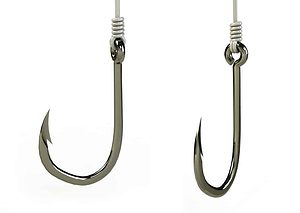
The only difference between a barbed hook and a barbless hook is a small “prong” near the sharp point of the hook. The barb acts as a retention point in the fish’s mouth to ensure that the hook does not fall from the lip of the fish when it is hooked.
What Is A Barbless Hook?
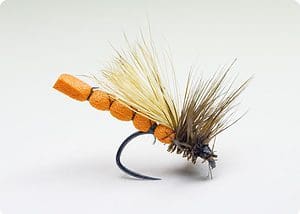
A barbless hook has no “prong”; the sharp point hooks into the lip, and by keeping tension on the line and is kept constant, then the fish cannot escape from the hook.
What Is A Barb On A Barbed Hook For?
Chances are, you already know what a barb is, but if some of our readers don’t, let’s ensure we are all on a level playing field before moving forward.
A hook barb is an extension protruding from the hook shank and sits below the point on the inside of the hook. The barb faces the opposite direction to the hook point, which makes it useful in a fishing context – more on that coming up.
What Is The Purpose Of The Barb On A Hook?
The barb on a fishing hook has two purposes.
The first purpose is to hold your bait on the hook, especially when you’re fishing with dead bait or live bait, as the barb stops the hook from pulling out of the bait while it’s swimming or being pulled at by fish in the water.
The second purpose of a barb is to stop the hook from falling out of a fish’s mouth once it has gone in. Since the barb faces the opposite way of the hook point, it stops the hook from being pulled in the opposite direction and keeps it in the fish’s mouth.
Using Barbed Fishing Hooks
Barbed fishing hooks have their place in the world of fishing and are probably the most popular hook used everywhere, and for good reasons, in most cases. Here are the good things about barbed fishing hooks
Holding Dead Or Live Baits
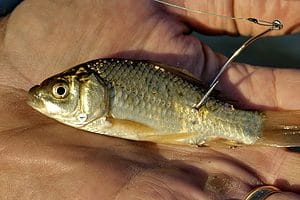
used with barbed hooks
Barbed hooks are designed, as I mentioned above, to hold on to natural baitfish such as herring, roach, or fish, whether dead or alive, particularly when predator fishing. They are also much better at holding squid or crab baits.
When you are using, say, a chunk of squid for bottom fishing or have hooked a live minnow in the back in the hope of a predator coming along, a barbed hook will be very effective at holding on to the bait.
When you’re bottom fishing with dead bait, fish will start pulling on the bait when they eat it, and without the barb, the bait can easily slip right off the hook after a few bites. You end up losing your bait more often and possibly catching fewer fish.
If you’ve hooked a live bait in the back, the barb stops the hook from falling out of the fish as it swims around and tries to break free. Without the barb, your live bait could fall off the hook before a bigger fish comes along and has a chance to eat it.
Keeping You Hooked Up
Once you have hooked a fish, a barbed hook is more likely to stay in the fish’s mouth than a barbless hook, but only if you lose tension on the fish.
If you fight a fish and keep tension on it all the time, chances are no hook would ever come out. But, when fish run at you and create slack, or jump, shake their head and create slack, a barbed hook is far more likely to hold onto the fish than a barbless one.
Barbed Are More Readily Available
When you buy hooks, approximately 75% of the hooks available in shops will be barbed, and therefore you’ll be able to buy the exact hook you want for any purpose, but it will have a barb.
Barbed hooks are available in more sizes and are generally slightly cheaper due to the manufacturing process for hooks being more widely used for barbed hooks.
Why Are Barbed Hooks Sometimes Banned?
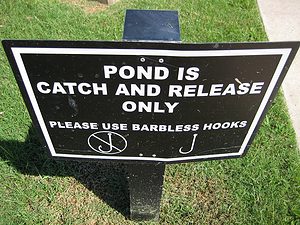
Barbed hooks are often banned as they cause more damage to fish than barbless hooks, and you’ll usually find this rule at catch-and-release fisheries.
This can be a controversial opinion, and some anglers have written articles arguing that the barbless hook can create more damage as it can move around more in the fish’s mouth and is not “anchored.” The movement from side to side potentially increases the hold in the fish’s lip, causing some small mouth damage.
In my opinion, most damage is caused when an angler tries to remove the hook from the mouth, and since the barb prevents this from being done easily, anglers tend to pull and be sometimes rough in trying to extract the hook. This is particularly an issue for young or inexperienced anglers.
So, this catch-and-release rule makes sense, as it will maintain fish health across the whole fishery population.
When Can Barbed Hooks Be Used Safely?
If you are fishing for saltwater fish or freshwater fish that you can remove and take home for eating purposes, then barbed hooks are the best option.
Barbed hooks give a slightly better chance of landing the fish, and any damage caused to the fish is irrelevant since you will kill the fish anyway.
Using Barbless Fishing Hooks
Barbless hooks come without barbs when you buy them or become barbless when you crimp the barb down. I always use barbless hooks when they suit the situation, and here is what is good about barbless fishing hooks.
Easier Hook Ups
When you’re fishing with barbless hooks, chances are you will find it easier to hook fish. When a fish eats a lure or bait with a barbless hook, and you go to set, nothing gets in the way of the hook going into the fish’s mouth.
By not having a barb, the hook can slip into the fish’s mouth unfettered with menial force, whereas if a barb were there, it would require an extra set to drive it into the fish’s mouth. Overall, barbless hooks slip into fish’s mouths more easily and with less force than barbed hooks.
They Are Better For The Fish
When a barbless hook enters a fish’s mouth, it goes in like a needle, whereas when a barbed hook goes into a fish’s mouth, it goes in like a needle initially, and then the barb takes a big chunk with it too.
By not having a barb, the part that holds the hook in a fish’s mouth, a barbless hook will slide right out of a fish’s mouth without causing it much damage. When you go to pull a barbed hook out of a fish’s mouth, you’ll need to shake it a bit and may take a small piece of the fish’s mouth with the hook.
Not only will it potentially remove a piece, but the handling time spent removing the barb will take the fish out of the water for too long and cause it stress. Now, if you plan to keep the intended fish for dinner, it doesn’t matter if the barb damages the fish more.
But, if you are releasing the fish, it will swim away in much better condition than if you used a barbless hook since you can slide it out of the fish’s mouth while it’s in the water with minimal handling, no air exposure, and without a chunk missing.
Barbless Are Easier For Fishing Catch & Release
It’s probably obvious to you now after what we went through above but using barbless hooks is much easier when fishing catch and release.
When releasing fish, you must be certain that the fish swim away in as good a condition as possible. By being able to slide a hook out of a fish’s mouth with minimal force, minimal handling, and minimal air exposure, it will swim away in the best condition possible.
Hook Safety – Barbless Are Much Safer For You
If you have ever had a hook go into your finger, hand, or head, and I have had all three, then taking it out of your finger, hand, or head is going to be a lot easier with a barbless hook.
Removing a barbless hook is as simple as pulling it back out the way it came. But pulling a barbed hook out of your hand the way it went in will leave a big chunk in your hand and hurt a lot.
To remove a barbed hook, you need to cut it with bolt cutters above the barb and then slide it through. A much longer and more troublesome process!
They Don’t Have To Fall Out Of Fish’s Mouths
Anglers mainly use barbed hooks instead of barbless hooks because they lose fewer fish after they have hooked them. However, losing a fish is almost always because of the wrong techniques that have been used.
The only reason you would ever lose a fish with a barbless hook is if you lost tension on the fish during the fight, which is just poor fishing technique. Now, you can not always control losing tension, but you can 90% of the time.
Barbless hooks will improve your fishing skills since you’ll work as hard as possible to ensure you stay tight on the fish.
Faster Handling
Removing a barbless hook is generally more time-consuming. If you are planning to enter fishing matches or are in a hurry, the hook removal process is much easier and means you can be back fishing quickly. Speed is key when match fishing.
Also, the quicker the fish is released means less time out of the water and a better opportunity for the fish to recover immediately.
How Do I Make A Barbed Hook Into A Barbless Hook?
If you only have barbed hooks and want to make it into a barbless hook, this involves taking a barbed hook and crimping down the barb with pliers in a squeezing motion on every hook you use.
Removing barbs from hooks can be quite tiresome when you have to do it all the time; even though it takes two seconds to crimp down a barb, the crimp’s quality and the hook’s strength can be compromised. Personally, I am not in favor of Flattening the barbs; I would prefer to buy the right hooks from the shops.
Barbed Vs. Barbless Hooks – Which Hooks Should You Use?
So, which hook should you use: barbed or barbless? This comes down to your opinion, and the choice is yours, but I would suggest using barbless 100% of the time unless you plan on eating the fish.
If you plan on eating the fish, then using barbed hooks makes sense since you don’t want to lose your dinner. But, when you’re fishing to release, using a hook that harms the fish much less and has a smaller chance of harming you makes sense to me.
Most anglers will own both hook types, and I suggest you do the same. Just keep them segregated and labeled correctly to avoid any potential of breaking laws or bans from fishing commercial waters.
What Is A Micro Barbed Hook?
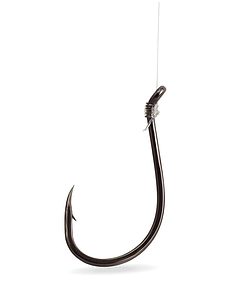
I left this question at the end of my article as it’s another option for some anglers. Micro barbs are a compromise between barbed and barbless hooks.
There is a barb on the hook, but it is much smaller; it works the same way as the normal barbed hook but is slightly easier to safely remove from the fish’s mouth.
Micro barb hooks are not commonly available and are usually available only in small sizes used by match fishermen. It should also be noted that some commercial fisheries also ban hooks with micro barbs.
Final Thoughts
Anglers have been debating the use of barbless hooks and barbed hooks for decades. Many have a split opinion; some anglers will only fish barbless, while others don’t use them unless the law or fishery rules dictate which type can be used.
There are cases for both types depending on the fishing you are doing and the species you are trying to catch; however, my personal choice is to use barbless where possible.
I hope this article gave you good insights into your hook options. You can read more on other topics, such as how to use a disgorger, and also my in-depth article on treble hooks.
- Top Tips For Fishing With Feathers - January 15, 2025
- How To Fish For Flounders: Tips, Rigs, & Baits - March 27, 2024
- Fortis Wraps Fishing Sunglasses: The Affordable Option For Anglers - January 25, 2024

